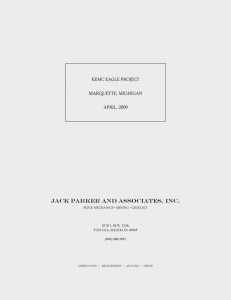UP Citizens Return to London to Address Rio Tinto About Eagle Mine
For pictures and more information visit: http://riotintoagm2009.wordpress.com/
London UK—A beleaguered Rio Tinto board defended itself from criticisms coming from a number of shareholders at the company’s annual general meeting (AGM) Wednesday (April 15th, 2009), in London, England. High on shareholder’s minds was the proposed $19.5 billion deal to sell access to a number of key company assets, including Kennecott, to the Chinese government-owned Chinalco as part of what many speakers described as offensive to existing shareholders and a direct result of poor investment and management decisions made by the company over the last several years.
At the meeting, Lutheran pastor, Jon Magnuson, from Marquette, Michigan, presented a document signed by one hundred faith leaders of ten faith traditions in Marquette, Baraga and Keweenaw counties. Magnuson said that the document was part of a petition that collected roughly ten thousand citizen’s names in opposition to Rio Tinto’s Eagle Project nickel and copper mine, located on the Yellow Dog Plains, in Marquette County.
“Many of our parishioners and members of our faith communities are . . . involved in the mining industry,” said Magnuson. “But on this particular project we have taken a very strong position – in this place, at this time, for these specific reasons. And one is the massive environmental damage that is threatened to the Great Lakes and the second and most prominent concern is that, what we perceive and experience is a cavalier dismissal of the claims of one of the major Indian tribes in Michigan, the Keweenaw Bay Indian Community.”
In response, company CEO Tom Albanese said that Rio Tinto is “not unmindful of the questions and the controversy” and claimed that Rio Tinto Copper CEO Bret Clayton “visited the site and met with a number of the stakeholders as a result of requests of some of the questions that came up in last year’s AGM.”
While Clayton did visit with a number of parties sympathetic to the mine’s development, including the local Chamber of Commerce and various local politicians, he made no attempt to meet with Michigan citizens and tribal representatives while in the area.
Gabriel Caplett, from Skandia, Michigan, spoke to a lack of competence and care in designing the Eagle Project mine.
“I’m just wondering if other shareholders are curious as to why this project hasn’t been brought on line yet and I think there’s a very simple reason for that and it lies within the mine design itself,” said Caplett. “The mine as designed could be charged with fraud under Michigan’s metallic mining law. The mine, as designed, would collapse – the crown pillar holding up the mine ceiling would collapse. Many technical experts have agreed on that.”
Caplett explained that Dr. David Sainsbury, a rock mechanics expert hired by the State of Michigan to review the mine’s mine structure inquired with Rio Tinto if anyone at the company had rock mechanic’s expertise. “He didn’t receive a response,” said Caplett. Sainsbury, who was transferred to work overseas after continually reporting to the State that the company’s conclusions regarding the crown pillar’s stability were “not defensible,” told a mine engineering colleague that the Eagle application, produced by Golder & Associates and Foth & VanDyke, was equivalent to “high school level” work.
Caplett asked the Rio Tinto board if, “after deferring the Eagle Project mine are you willing to waste any more shareholder money on this project or will you ultimately abandon it instead of pursuing this project.”
Two shareholders addressed concerns regarding Rio Tinto’s continued involvement in the controversial Grasberg Mine, in West Papua. According to shareholder Andrew Hickman, last year the government of Norway divested roughly $800 million in shares, calling the company’s record in West Papua “grossly unethical”. Hickman said that mine officials have acknowledged to paying the Indonesian military “less than” $1.6 million to guard the facility and repress local opposition to the mine.
Other shareholders addressed the recently acknowledged leakage of roughly one-hundred thousand liters of contaminated tailings water at Rio Tinto’s Ranger uranium mine, in Australia; as well as concerns regarding the company’s joint venture arrangement with Muriel Mining Co. in Columbia that has forced the relocation of an indigenous community and occupied a sacred mountain.
The Reverend Magnuson and Caplett have also met with representatives at the Church of England’s Pension Board and Ethical Investment Advisory Group and will be meeting with the United Kingdom’s Department for Business Enterprise and Regulatory Review on Friday.
For more information, or to conduct an interview, please contact Teresa Bertossi at teresa@savethewildup.org
